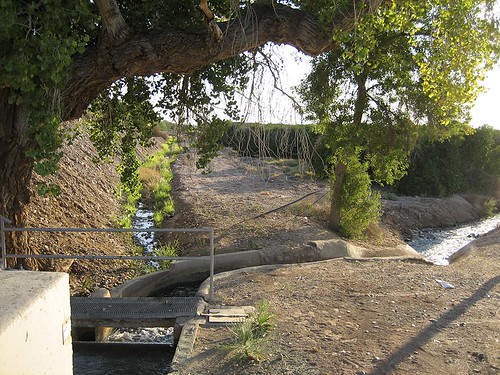Doug MacEachern has a fascinataing discussion in today’s Arizona Republic about the canals of Phoenix. I remember being struck the first time I visited Phoenix by these strange concrete waterways. I’d driven up to the north end of town to make a pilgrimage to the (sorta) Frank Lloyd Wright Biltmore, an oasis of a thing built for the rich. It’s green and luxuriant, and then right in front is this big concrete river carrying water past, and the Biltmore’s architecture completely ignores it, like its only relevance was as an obstacle to the entrance road.
A few years back, when Lissa and I visited Phoenix, we spent some time ambling around trying to look at the canals. It was hard. They’re not rivers. They’re plumbing. This picture is the best I could find from our trip, a little diversion structure taking water out of one of the big canals down the hill to a neighborhood of citrus groves:
The actual concrete canal is up to the left, completely ignored by the neighborhoods that surround it – in fact largely inaccessible.
MacEachern writes about a discussion going on now in Phoenix about the possibility of reintegrating the canals into the cityscape, the way they apparently used to be:
Especially during the rapid expansion of the urban Valley after World War II, SRP’s dedication to efficient, effective water delivery rapidly began altering a once-cozy relationship of the Valley’s communities to their canals.
Where a formerly agrarian Valley was once resplendent with tree-lined, earthen canals, the post-war canals were remodeled quickly into . . . something else. The thousands of enormous cottonwoods that once proliferated along the earthen canal banks began disappearing. And the canals themselves, which once provided easy access for swimmers and picnickers, were covered over in steep, foreboding concrete.
It echoes a similar discussion going on now in Albuquerque, regarding the extent to which the network of irrigation ditches criss-crossing the valley floor should be treated more broadly as a network of recreational trails. From Gwyneth Doland:
For years, residents in Albuquerque’s North Valley have been pushing for a formalized system of recreation trails along the irrigation ditches, or acequias, an idea the current board has unanimously rejected. Supporters of the trail plan are hoping that electing new board members will pave the way to change.
The discussion here is a little different. The ditch banks in Albuquerque’s valley are already embraced as informal recreational trails by many, and the argument here is not so much about whether that is a good thing, but about the ways in which it might be formalized.
But in both the Phoenix and Albuquerque cases, it highlights a classic market failure – a positive externality (recreational benefits for all!) that is not internalized in our formal decision-making about the management of our water system.


Pingback: Twitted by loticwater